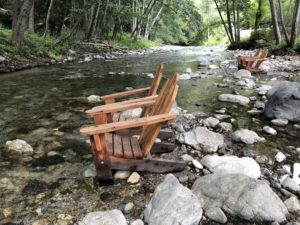-
Big Sur River Inn: Dip Your Toes in the River
The venerable Big Sur River Inn is perched on the banks of the Big Sur River. It began humbly in 1934, when Ellen Brown opened the inn and began serving hot apple pie to guests. Her famous apple pie, which is still on the menu today, gave the place its original name, “Apple Pie Inn”. Ellen was a descendant of the famous Pfeiffer family for whom a park and beach are named.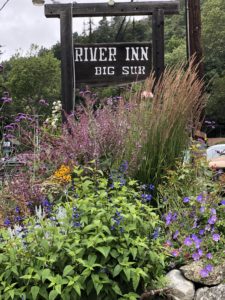
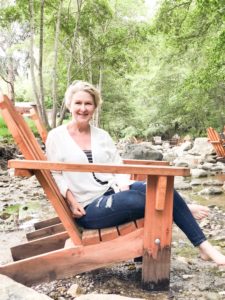 The Big Sur River Inn is now known for its famous Adirondack chairs in the river. Yes, IN the river. I must add that the river is so shallow, a chicken could wade across and get nary a feather wet. It is also well shaded and lined with gorgeous smooth river stones. You can take your glass of wine or bottle of beer and sit IN THE RIVER with your family and friends. You will love dipping your toes in the cool and crystal clear water. Could there be anything more idyllic on a hot day? Big Sur River Inn is located on the west side of Highway 1 and is surrounded by lush forestry and campgrounds. Its central location makes it an ideal place from which to explore Big Sur’s redwoods, hidden coves, and famous landmarks. It is less than 3 miles from Big Sur Station, Andrew Molera State Park, and Pfeiffer Big Sur State Park.
The Big Sur River Inn is now known for its famous Adirondack chairs in the river. Yes, IN the river. I must add that the river is so shallow, a chicken could wade across and get nary a feather wet. It is also well shaded and lined with gorgeous smooth river stones. You can take your glass of wine or bottle of beer and sit IN THE RIVER with your family and friends. You will love dipping your toes in the cool and crystal clear water. Could there be anything more idyllic on a hot day? Big Sur River Inn is located on the west side of Highway 1 and is surrounded by lush forestry and campgrounds. Its central location makes it an ideal place from which to explore Big Sur’s redwoods, hidden coves, and famous landmarks. It is less than 3 miles from Big Sur Station, Andrew Molera State Park, and Pfeiffer Big Sur State Park.
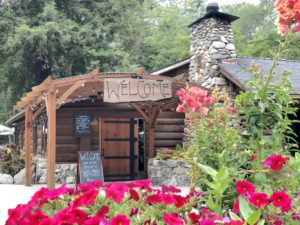 Since I am a local resident, I have never stayed at the Inn, but I have eaten at their restaurant and the food is amazingly delicious. They offer breakfast, lunch and dinner menus. You may choose to eat indoors in their rustic cabin-like dining room, on their lovely deck, or in those famous chairs in the river. Big Sur River Inn clearly take pride in their landscaping, so that in every direction you look you see a beautiful floral vista. There are also a myriad of wildlife here. During my most recent visit, I was serenaded by a group of gorgeous blue Steller’s Jays as they socialized on the river bank.
Since I am a local resident, I have never stayed at the Inn, but I have eaten at their restaurant and the food is amazingly delicious. They offer breakfast, lunch and dinner menus. You may choose to eat indoors in their rustic cabin-like dining room, on their lovely deck, or in those famous chairs in the river. Big Sur River Inn clearly take pride in their landscaping, so that in every direction you look you see a beautiful floral vista. There are also a myriad of wildlife here. During my most recent visit, I was serenaded by a group of gorgeous blue Steller’s Jays as they socialized on the river bank.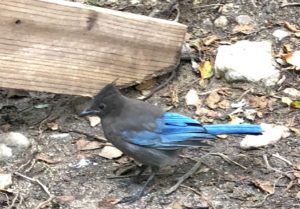 On Sunday afternoons, there is live music on the riverside deck. There is also a gas station (the only one for miles) and a small general store with food and camping supplies on the premises. For more information see River Inn. If you are searching for a down-to-earth, affordable, fun and relaxing place to visit, I would highly recommend the Big Sur River Inn!
On Sunday afternoons, there is live music on the riverside deck. There is also a gas station (the only one for miles) and a small general store with food and camping supplies on the premises. For more information see River Inn. If you are searching for a down-to-earth, affordable, fun and relaxing place to visit, I would highly recommend the Big Sur River Inn!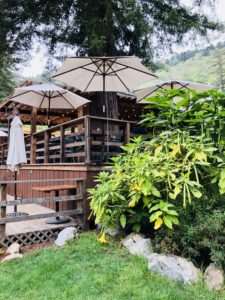 Thank you for visiting my blog! Wishing you peace, love, happiness, & beautiful vistas!
Thank you for visiting my blog! Wishing you peace, love, happiness, & beautiful vistas! -
McWay Falls: Beauty & History in Big Sur
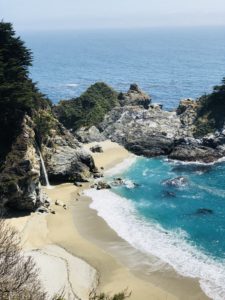 Have you ever imagined living in a home overlooking a gorgeous ocean cove, with a redwood forest behind you? What if you could look out your bedroom window and see an 80-foot waterfall cascading down a granite cliff onto a beautiful beach? One lucky couple, Congressman Lathrop Brown and his wife, Helene, were privy to this view for many years. Lathrop Brown served as best man at his friend Franklin Delano Roosevelt’s wedding. His wife, Helene, was a wealthy heiress. In 1924 they visited Big Sur and became smitten with the area. They purchased Saddle Rock Ranch from pioneer homesteader Christopher McWay. They built a crude redwood cabin at the top of the cliffs facing McWay Falls. In 1940, they replaced this with a fancy two-story mansion. They named it “Waterfall House”.Waterfall House featured fine furnishings, paintings, and an entryway inlaid with brass fish, a gold octopus, and a rose compass. Their ranch foreman, Hans Ewoldsen, built a Pelton wheel from hand-split redwood and installed it on McWay Creek in 1932. This wheel supplied a 32-volt generator with the first source of electricity in Big Sur. It powered three homes, a blacksmith shop, and a funicular railway. What is a funicular railway, you ask? It is a railway on an incline. The Browns used a modified mining car operated by cable to travel up and down the steep Big Sur slope.The Browns left Big Sur for Florida in 1956, and after her husband died, Helene donated the property to the state for a museum and park. For various reasons, the home was demolished in 1965. Helene had stipulated that the park be named for her friend, Julia Pfeiffer Burns, “a true pioneer”. Julia, with her husband, raised cattle at Saddle Rock Ranch before the Browns’ arrival. At the overlook of McWay Falls, you can still see vestiges of the Brown home, landscaping, and railway.Photographers love this area, and it is easy to see why. The sand is often purple from the erosion of manganese garnet which is carried down the creek to the beach. This is generally more apparent after winter storms. Light plays on the colored sand and waves crash through sea sculptured arches and rock formations, creating a beautiful vista. The hills are covered with wild yarrow and pink morning glories. The area is surrounded by redwood, tan oak, madrone, and chaparral. Tall, stately eucalyptus trees line the trail and fill the air with their scent.
Have you ever imagined living in a home overlooking a gorgeous ocean cove, with a redwood forest behind you? What if you could look out your bedroom window and see an 80-foot waterfall cascading down a granite cliff onto a beautiful beach? One lucky couple, Congressman Lathrop Brown and his wife, Helene, were privy to this view for many years. Lathrop Brown served as best man at his friend Franklin Delano Roosevelt’s wedding. His wife, Helene, was a wealthy heiress. In 1924 they visited Big Sur and became smitten with the area. They purchased Saddle Rock Ranch from pioneer homesteader Christopher McWay. They built a crude redwood cabin at the top of the cliffs facing McWay Falls. In 1940, they replaced this with a fancy two-story mansion. They named it “Waterfall House”.Waterfall House featured fine furnishings, paintings, and an entryway inlaid with brass fish, a gold octopus, and a rose compass. Their ranch foreman, Hans Ewoldsen, built a Pelton wheel from hand-split redwood and installed it on McWay Creek in 1932. This wheel supplied a 32-volt generator with the first source of electricity in Big Sur. It powered three homes, a blacksmith shop, and a funicular railway. What is a funicular railway, you ask? It is a railway on an incline. The Browns used a modified mining car operated by cable to travel up and down the steep Big Sur slope.The Browns left Big Sur for Florida in 1956, and after her husband died, Helene donated the property to the state for a museum and park. For various reasons, the home was demolished in 1965. Helene had stipulated that the park be named for her friend, Julia Pfeiffer Burns, “a true pioneer”. Julia, with her husband, raised cattle at Saddle Rock Ranch before the Browns’ arrival. At the overlook of McWay Falls, you can still see vestiges of the Brown home, landscaping, and railway.Photographers love this area, and it is easy to see why. The sand is often purple from the erosion of manganese garnet which is carried down the creek to the beach. This is generally more apparent after winter storms. Light plays on the colored sand and waves crash through sea sculptured arches and rock formations, creating a beautiful vista. The hills are covered with wild yarrow and pink morning glories. The area is surrounded by redwood, tan oak, madrone, and chaparral. Tall, stately eucalyptus trees line the trail and fill the air with their scent.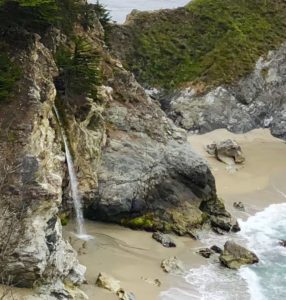
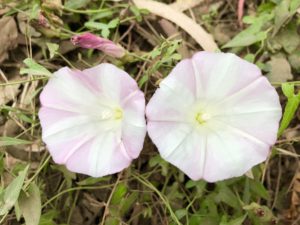
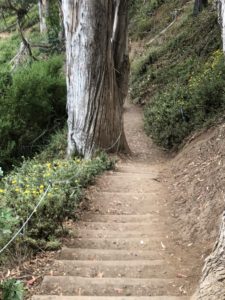 The waterfall flows year round from McWay Creek and is one of only two entering the ocean in California. Visitors are not allowed access to the beach to protect the marine resources and the pristine beauty of the cove. Per Julia Pfeiffer Burns State Park, ” Cliff areas beyond the fenced boundaries, including the BEACH, SADDLE ROCK and MCWAY FALLS area are completely off limits. Trespassing into these closed areas is a serious offense, resulting in a citation and arrest. The areas are extremely hazardous.” Be safe and stay on the Waterfall Trail.
The waterfall flows year round from McWay Creek and is one of only two entering the ocean in California. Visitors are not allowed access to the beach to protect the marine resources and the pristine beauty of the cove. Per Julia Pfeiffer Burns State Park, ” Cliff areas beyond the fenced boundaries, including the BEACH, SADDLE ROCK and MCWAY FALLS area are completely off limits. Trespassing into these closed areas is a serious offense, resulting in a citation and arrest. The areas are extremely hazardous.” Be safe and stay on the Waterfall Trail.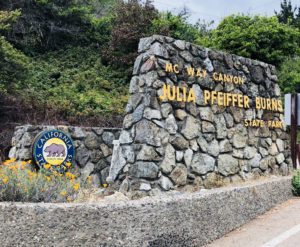
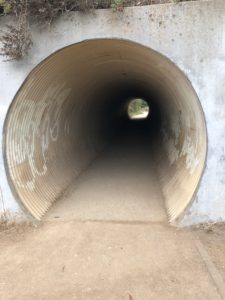
The Tunnel leading from adjacent Parking Lot to Trail You can reach McWay Falls either by 1. parking at JPBSP and walking through a short tunnel under the highway, or 2. parking alongside highway 1 and hiking on the Waterfall Trail to the viewing area. There is a 10.00 fee to park at JPBSP. It opens 30 minutes before sunrise and closes 30 minutes after sunset. There are restrooms available there. If you park along the highway, be mindful of traffic as this is a busy road. Also, if you park on the road, you will have to go down a set of several steps to reach the trail. You may also want to bring a sweater or jacket as it can get quite blustery here.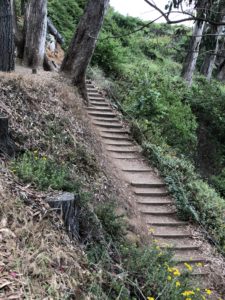
Stairs from Hwy 1 to Trail 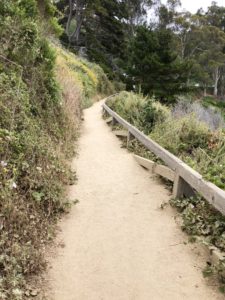
The Trail is Easy to Navigate For more information see parks.ca.gov Thank you for visiting my blog! Wishing you peace, love, happiness, and beautiful vistas!
-
Point Sur Lighthouse in Big Sur, California
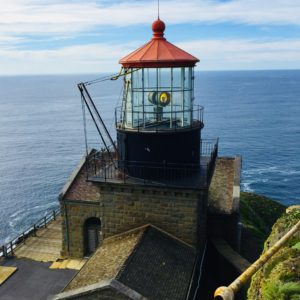 Located between Carmel and Big Sur, the 48-foot high sandstone Point Sur lighthouse stands duty, warning ships approaching the treacherous coast. Point Sur, a National Historic Landmark, is the only complete turn-of-the-century light station open to the public in California. The lighthouse was originally fueled by whale oil, lard oil, and kerosene before becoming electric in 1948. It used a Fresnel lens invented by Augustin Jean Fresnel, a French physicist, until the 1970s. It is still in use today, operated by the U.S. Coast Guard.
Located between Carmel and Big Sur, the 48-foot high sandstone Point Sur lighthouse stands duty, warning ships approaching the treacherous coast. Point Sur, a National Historic Landmark, is the only complete turn-of-the-century light station open to the public in California. The lighthouse was originally fueled by whale oil, lard oil, and kerosene before becoming electric in 1948. It used a Fresnel lens invented by Augustin Jean Fresnel, a French physicist, until the 1970s. It is still in use today, operated by the U.S. Coast Guard. 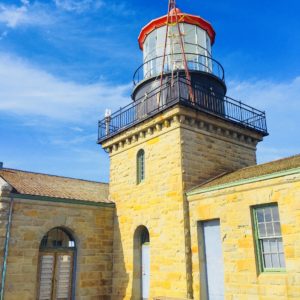
During its history, Point Sur has been home to four lightkeepers and their families. Beginning in 1899 up until 1974, these lighthouse keepers and their families lived in isolation in this remote and desolate place. Supplies were brought every four months by ship. It is hard to imagine what life must have been like for these folks, without the modern conveniences that we take for granted and so distant from the rest of the world. To live at Point Sur clearly required grit. Point Sur could originally be reached only by boat, as it was an island. Now, it is reached by walking a little less than a mile from the parking lot below.
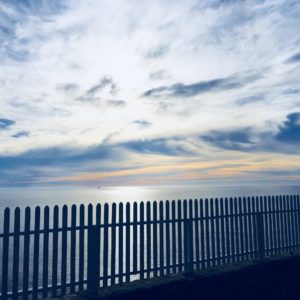 Despite a light that could be seen for 23 nautical miles and a coal-powered fog horn, the Point Sur lighthouse still witnessed its share of shipwrecks. If you are interested in ghosts and haunted places, you may enjoy the Ghost Hunts and annual Halloween Tours. Nature lovers may also enjoy the Whale Watch Tours. Gray whales are often seen on their migration route during the winter and during the summer you may see humpback and blue whales.
Despite a light that could be seen for 23 nautical miles and a coal-powered fog horn, the Point Sur lighthouse still witnessed its share of shipwrecks. If you are interested in ghosts and haunted places, you may enjoy the Ghost Hunts and annual Halloween Tours. Nature lovers may also enjoy the Whale Watch Tours. Gray whales are often seen on their migration route during the winter and during the summer you may see humpback and blue whales. 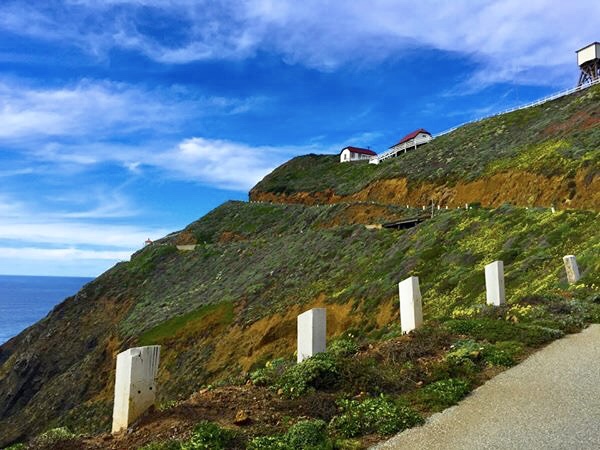 Tours last approximately three hours and are led by docents. It can be very cold and blustery so bring a jacket or sweater to be on the safe side. You will also have to do a great deal of walking, so sensible footwear is advised. You have to climb almost a mile with a 360-foot elevation to get to the lighthouse. There is a picnic area surrounded by a cute picket fence so bring a lunch and enjoy the amazing views! If you are planning on visiting the lighthouse and have questions regarding parking, fees, and tour schedules, call 831-625-4419 or see Point Sur Lighthouse
Tours last approximately three hours and are led by docents. It can be very cold and blustery so bring a jacket or sweater to be on the safe side. You will also have to do a great deal of walking, so sensible footwear is advised. You have to climb almost a mile with a 360-foot elevation to get to the lighthouse. There is a picnic area surrounded by a cute picket fence so bring a lunch and enjoy the amazing views! If you are planning on visiting the lighthouse and have questions regarding parking, fees, and tour schedules, call 831-625-4419 or see Point Sur Lighthouse- September through March Tours are Saturday and Sunday at 10:00 am and Wednesday at 1:00 pm
- April through August Tours are Saturdays and Wednesdays at 10:00 am and 2:00 pm, Sundays 10:00 am, and only in July and August, Thursdays at 10:00 am
- For regular tours, adults are $15, ages 6-17 are $5, and children 5 and under are free
- Moonlight Tours in 2018 are Sunday, August 26 and Monday August 27 at 6:45 pm, and Monday, September 24 and Tuesday, September 25 at 6:00 pm
- For Moonlight tours, adults are $20, ages 6-17 are $10, and ages 5 and under are free
- Arrive early; first come, first served (reservations are not accepted)
- Visa, Mastercard, American Express and Discover are accepted
- No visitors may remain in their vehicles
- No pets ( even left in cars), large motorhomes or campers, baby strollers, or smoking is allowed
Thank you for visiting my blog! Wishing you peace, love, happiness & beautiful vistas!
